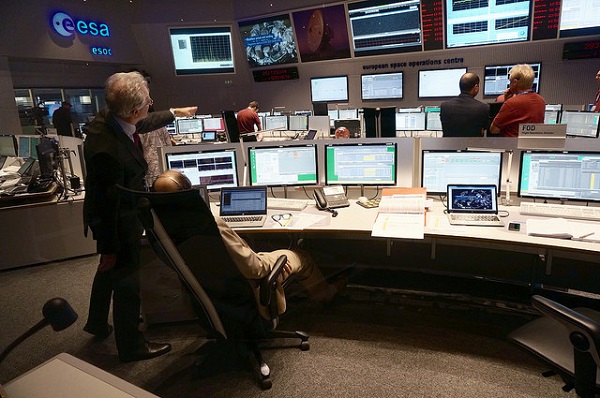Here's what we know so far about the fate European Space Agency's Schiaparelli mission.
| Update (October 20th): Well, ESA held the morning briefing as expected at 10:00 a.m. CEST, and the prognosis isn't good for the Schiaparelli lander. ESA spacecraft operations manager Andrea Accomazzo emphasized that this was an entry and descent test, and that the ExoMars Trace Gas Orbiter “is working perfectly.” ESA scientists also stressed that data analysis from the descent is still under scrutiny. Initial results suggest that the heat shield and parachute worked properly. Then, Accomazzo said, “the lander did not behave as expected” about 50 seconds prior to landing, probably because the back heat shield and parachute were ejected too early. The landing rockets did briefly fire and the ground detecting radar was activated, though their performance was less than nominal. MRO, Mars Express and MAVEN will continue to listen for Schiaparelli, though a comeback for a Mars lander 24 hours past landing would be a first.
Also: NASA's Opportunity rover did not spy Schiaparelli during the landing attempt. |
| Update (October 19th): Update: at this point, it is unclear whether Schiaparelli safely made it to the surface of Mars or not. “We still have much investigation to do,” says ESA ESOC head of operations Paolo Ferri in a recent briefing held at 20:30 CEST. Experts plan to analyze data from Mars Express, MRO and ground tracking stations overnight for a formal briefing on the situation tomorrow at 10:00 AM CEST/8:00 UT/4:00 AM EDT. |

ESA / ATG Medialab
Well, the 6 minutes of terror might be over, but scientists and engineers are now waiting for the joint European Space Agency / Roscosmos lander Schiaparelli to phone home — and chances are looking slim that it will.
This landing was a hoped-for first for the European Space Agency. It would have been a fitting comeback from the loss of the UK Space Agency's Beagle 2 lander, delivered by the Mars Express orbiter in 2003.
What we know thus far: A relay station in India picked up a signal as expected during descent, suggesting that the parachute deployed and that the lander separated from its protective aeroshell. However, the signal appeared to cut out. Now Mars Express data appears to agree. However, the ESA engineering team is still analyzing the data, including new information from the Mars Reconnaissance Orbiter — they'll be working through the night to assess the situation. Expect an update Thursday morning.

ESA / Shlyaev
The landing was set to occur today on Meridiani Planum at 10:48 a.m. EDT (14:48 Universal Time). The landing targeted a 100-by-15-km ellipse. Signals from Schiaparelli — also called the entry, descent and landing demonstration module (EDM) — were picked up by the Giant Metre Wave radio Telescope (GMRT) near Pune, India. Although the signal was extremely faint, as expected, those signals were confirmed later by the Mars Express relay.
Running on batteries only, Schiaparelli was built to function for only 2 to 8 sols (Martian days) before succumbing to the austere environment. The EDM lander's primary mission was a proof of concept, a demonstrator to test the landing platform for the full scale ExoMars rover that will launch in 2020. Schiaparelli's main science was to be carried out during descent, though it intended to analyze the environment on the surface as well using its Dust characterization, Risk assessment and Environment Analyzer on the Martian Surface (DREAMS) package.
“Landing during the start of dust storm season is not really a deliberate plan, but it will provide a unique opportunity,” says EDM project manager Thierry Blancquaert (ESA). “Because this is a technology demonstration mission, most of the key information will come from the descent phase.”
Meanwhile, high overhead, the ExoMars Trace Gas Orbiter fired its engines at 13:15 UT (11:15 a.m. EDT) today, giving the Red Planet a miss and entering orbit to begin science operations as planned. TGO gave us all a start on Sunday, when ESA controllers briefly lost telemetry for about an hour after Schiaparelli's separation. All is well now, as the orbiter settles in for science operations in a 4-sol orbit around the Red Planet.
It's getting crowded around Mars now: orbital roll call includes NASA's MRO, MAVEN, and Mars Odyssey; India's Mars Orbiter Mission; and the ESA's Mars Express and Trace Gas Orbiter. The latter will serve as a data relay for the 2020 ExoMars rover.Waiting for Schiaparelli:
What to Expect in the Days Ahead
Assuming it made it safely to the Martian surface, Schiaparelli will temporarily power its transmitter down to conserve precious battery power. Mars Express, MAVEN, and stations on Earth will listen for Schiaparelli until the Trace Gas Orbiter is back in range to resume relay. If Schiaparelli phones home over the next 24 hours, watch for 15 descent images snapped by the Descent Entry Camera (DECA) once every 1½ seconds on the way down. DECA is fixed on the lander's underside to chronicle the descent, so we don't expect to see any surface images from Schiaparelli post landing — unless, of course, it landed on its side, just right!
Also, there's no word yet if NASA's nearby Opportunity rover spied Schiaparelli in the act of landing from its perch on Endeavour crater, though it'll probably only nab a pixel or two at most.The vigil and recovery effort to contact for the Schiaparelli lander is now underway. We'll update the developing story of the Schiaparelli landing as it unfolds. If successful, watch for final science results from the short Schiaparelli mission by the end of the month. One week may not sound like much, but it will pave the way for a longer stay in 2020.
 1
1









Comments
Frank-ReedNavigation.com
October 20, 2016 at 2:35 pm
Another unfortunate failure. It seems likely now that this lander impacted the surface at high speed. Either the rockets shut off prematurely, or the parachute system did not perform as expected leaving the spacecraft falling at very high speed before the rockets fired. In either case, perhaps the Opportunity rover's images should be inspected for a hint of a plume of dust from a high-speed impact.
Since the Beagle 2 lander has been the subject of so much negative discussion and even ridicule over the years, it is perhaps worth noting that that small, low-cost British Mars lander was apparently somewhat more successful than the bigger Schiaparelli lander. MRO images which appear to show Beagle 2 indicate that it had a successful soft landing on Mars. It failed immediately after landing.
It's often said that "Mars is hard" and only about half of all Mars landers have succeeded. But let's be clear: NASA's landers have been overwhelmingly successful with only one failure among eight landers. All other attempts at landing have so far been mission failure (both the Russian/Soviet Mars 3 and the British Beagle 2 were minimal engineering successes in that they successfully landed --and that's hard-- but both were "mission" failures which returned no data from the surface). No doubt those statistics will change and soon. They'll get it eventually!
Frank Reed
Conanicut Island USA
You must be logged in to post a comment.
You must be logged in to post a comment.